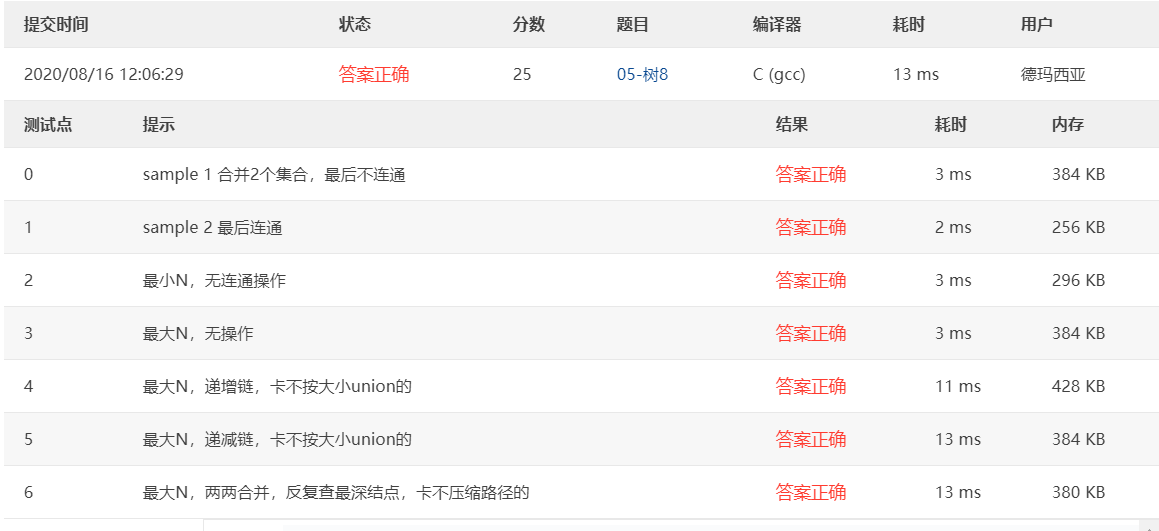05-树8 File Transfer (25分)
We have a network of computers and a list of bi-directional connections. Each of these connections allows a file transfer from one computer to another. Is it possible to send a file from any computer on the network to any other?
Input Specification:
Each input file contains one test case. For each test case, the first line contains N (2), the total number of computers in a network. Each computer in the network is then represented by a positive integer between 1 and N. Then in the following lines, the input is given in the format:
I c1 c2
where I stands for inputting a connection between c1 and c2; or
C c1 c2
where C stands for checking if it is possible to transfer files between c1 and c2; or
S
where S stands for stopping this case.
Output Specification:
For each C case, print in one line the word "yes" or "no" if it is possible or impossible to transfer files between c1 and c2, respectively. At the end of each case, print in one line "The network is connected." if there is a path between any pair of computers; or "There are k components." where k is the number of connected components in this network.
Sample Input 1:
5 C 3 2 I 3 2 C 1 5 I 4 5 I 2 4 C 3 5 S
Sample Output 1:
no no yes There are 2 components.
Sample Input 2:
5 C 3 2 I 3 2 C 1 5 I 4 5 I 2 4 C 3 5 I 1 3 C 1 5 S
Sample Output 2:
no no yes yes The network is connected.
提交测试代码:
#include <stdio.h> #include <stdlib.h> #define MAXSIZE 10000 typedef int ElementType; typedef int SetName; typedef ElementType SetType[MAXSIZE]; //路径压缩 SetName Find(SetType S, ElementType X){ if(S[X] < 0){ return X; } else{ return S[X] = Find(S, S[X]); } } //普通查找 //SetName Find(SetType S, ElementType X){ // for(;S[X]>=0; X=S[X]); // return X; //} /*按秩归并的两种实现*/ //按树高归并 //void Union(SetType S, SetName Root1, SetName Root2){ // if(S[Root2] < S[Root1]){ // S[Root1] = Root2; // } // else{ // if(S[Root1] == S[Roo2]) S[Root1]++; // S[Root2] = Root1; // } //} //按规模(元素个数)归并 void Union(SetType S, SetName Root1, SetName Root2){ if(S[Root2] < S[Root1]){ S[Root2] += S[Root1]; S[Root1] = Root2; } else{ //if(S[Root1] == S[Roo2]) S[Root1]++; S[Root1] += S[Root2]; S[Root2] = Root1; } } void Initialization(SetType S, int n){ for(int i=0; i<n; ++i){ S[i] = -1; } } void Input_connection(SetType S){ ElementType u, v; SetName Root1, Root2; scanf("%d %d ", &u, &v); Root1 = Find(S, u-1); Root2 = Find(S, v-1); if(Root1 != Root2) Union( S, Root1, Root2); } void Check_connection(SetType S){ ElementType u, v; SetName Root1, Root2; scanf("%d %d ", &u, &v); Root1 = Find(S, u-1); Root2 = Find(S, v-1); if(Root1 == Root2){ printf("yes "); } else printf("no "); } void Check_network(SetType S, int n){ int counter = 0; for(int i = 0; i < n; i++){ if(S[i] < 0){ counter++; } } if(counter == 1){ printf("The network is connected. "); } else{ printf("There are %d components. ", counter); } } int main() { SetType S; int n; char in; scanf("%d", &n); Initialization(S, n); do { scanf("%c", &in); switch(in){ case 'I': Input_connection(S); break; case 'C': Check_connection(S); break; case 'S': Check_network(S, n); break; } }while(in != 'S'); return 0; }
测试结果:
